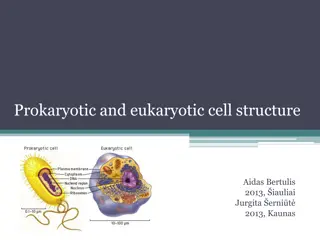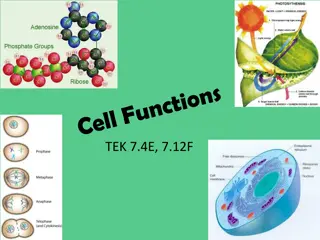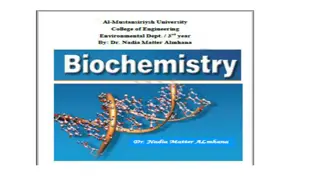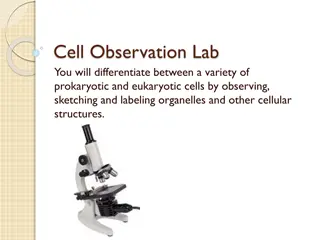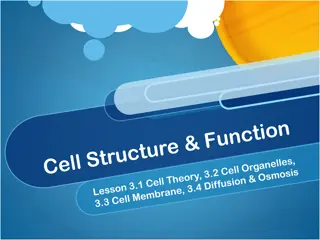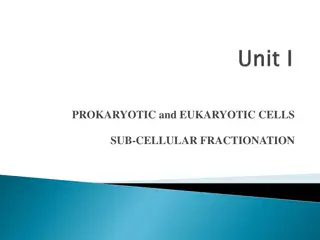Overview of Cell Division in Prokaryotes and Eukaryotic Cells
Cell division plays a crucial role in the growth and reproduction of all organisms. In prokaryotic cells, binary fission is the primary mode of division, while eukaryotic cells undergo a more complex process involving cell growth, DNA replication, chromosome distribution, and cytokinesis. The cell cycle consists of key phases such as interphase and cell division, each serving specific functions in preparing the cell for division. Understanding the mechanisms of cell division is essential for grasping the fundamental processes of life and genetics.
Download Presentation

Please find below an Image/Link to download the presentation.
The content on the website is provided AS IS for your information and personal use only. It may not be sold, licensed, or shared on other websites without obtaining consent from the author. Download presentation by click this link. If you encounter any issues during the download, it is possible that the publisher has removed the file from their server.
E N D
Presentation Transcript
Department of Anesthesia Techniques Prof . Dr. YounisA. Alkhafaji younis.abdulridha@uomus.edu.iq Lecture 4 - Cell cycle Cell division in prokaryotes A- typically, a prokaryotic cell divides by binary fission, splitting into two nearly equal halves B-the main circular DNA molecule of the cell is replicated C-new plasma membrane and cell wall materials are laid down between the two DNA circles, eventually separating the daughter cells D-prokaryotic cells can have a generation time (general term for the period from the start of one cell division to the start of the next cell division) as short as 20 minutes
Cell division in eukaryotic cell : Cell division is a very important process in all living organisms. The division cycle of most cells consists of four coordinated processes: cell growth, DNA replication, distribution of the duplicated chromosomes to daughter cells, and cell division. Eukaryotic DNA molecules are organized in chromosomes each chromosome is made of chromatin, a long DNA molecule with associated proteins each chromosome contains hundreds to thousands of genes each species has a characteristic number of chromosomes chromosomes carr y the genetic information of a cell from one cell generation to the next. Chromosome consists of two chromatids or sister chromatids join together by centromer which responsible for the movement of chromosomes at cell division
Each species has a characteristic chromosome number; for instance, human cells contain 46 chromosomes, corn has 20 chromosomes. The full number or called diploid (2n) number of a chromosome that occurs in all cells of the body. The diploid number includes two chromosomes of each kind. Half the diploid number is called the haploid (n) number of chromosomes, representing only one of each kind of chromosome. In the life cycle of many animals, only sperm and eggs have the haploid number of chromosomes. Cell cycle has two main phases interphase and cell division (mitosis + cytokinesis). The cytokinesis mean cytoplasmic division of a cell at the end of mitosis or meiosis , bringing about the separation into two daughter cells.
Cell cycle has two main phases interphase and cell division (mitosis + cytokinesis) Interphase is the longest stage in the eukaryote cell cycle. During interphase, the cell acquires nutrients, creates and uses proteins and other molecules, and starts the process of cell division by replicating the DNA. Interphase is divided into three distinct stages, Gap 1, S, and Gap 2. The purpose of interphase in all cell types is to prepare for cell division, which happens in a different stage of the cell cycle. G1phase It is the post mitotic phase and first phase within interphase. After cells have finished dividing their chromosomes, and cytokinesis has divided the cell membrane, the two new cells enter the first stage of interphase, Gap 1 or G1. During this stage, the cell performs its normal functions, and grows in size, the cell replicates organelles as necessary, cells double in organelles, accumulates materials needed for DNAsynthesis and cell division
S phase It is the synthesis phase during this phase duplication of DNA and centriole takes places. The duplication of DNA results in the duplication of chromosomes. Thus, during this phase, the amount of DNA in the cell has effectively doubled G2 phase It is the pre- mitotic phase (invisible phase) the synthesis of RNA and protein continues in this phase. The formation of macro molecules for spindle formation takes place and the cell prepare itself to go into the mitotic phase.
M phase or Mitotic phase During the mitotic (M) phase, the cell divides its copied DNA and cytoplasm to make two new cells. M phase involves: mitosis and cytokinesis. 1. mitosis is the process that distributes a complete copy of the duplicated genetic information to each daughter cell 2. cytokinesis is the process of dividing the cytoplasm into two separate cells - some cells can have mitosis without cytokinesis (most common in fungi and slime molds) Mitosis is nuclear division that produces two daughter nuclei, each with the same number and kinds of chromosomes as the parental nucleus.
M phase is divided into four phases. These phases are; prophase, metaphase, anaphase, and telophase. Prophase During prophase, the chromosomes supercoil and the fibers of the mitotic spindle begin to form between centrosomes located at the pole of the cells. The nuclear membrane also disintegrates at this time, freeing the chromosomes into the surrounding cytoplasm. Prometaphase During prometaphase, some of the fibers attach to the centromere of each pair of sister chromatids and they begin to move toward the center of the cell. Metaphase At metaphase the chromosomes align along the center plane of the cell.
Anaphase During anaphase, the centromeres split and the sister chromatids begin to migrate toward the opposite poles of the cell Telophase During telophase, the chromosomes at either end of the cell begin to cluster together, which facilitates the formation of a new nuclear membrane. This also is when cytokinesis occurs, leading to two separate cells. One way to identify that telophase has begun is by looking for the formation of the cell plate, the new cell wall forming between the two cells
T H A N K S




